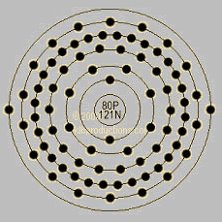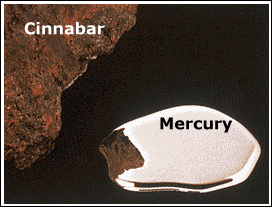also called Quicksilver


Symbol: Hg
Atomic Number: 80
Atomic Mass: 200.59 amu
History
The exact date that mercury was first discovered is unkown, but the Babylonians are credited with referring to it in writing for the first time about 3,000 years ago. Mercury was used by the ancient Chinese and Hindus, mainly for medical and spiritual purposes, and was found in Egyptian tombs from 1500 BC. The Chinese thought mercury would give you a healthy and long life, the Greeks used mercury as ointments and in medicine, and the Romans used mercury for cosmetics. By 500 BC, mercury was important in alchemy for making different kinds of metals. In fact, even the name alchemy means "the way of mercury."
Later in history, about mid 1700's to mid 1800's, mercury was used in the making of felt hats. The fumes from this technique were highly toxic, and often caused the hatters (the people making the hats) to become poisoned, which caused tremors, insomnia, and hallucinations. This is probably where the term "mad as a hatter" came from.
Today, mercury is used for the manufacture of industrial chemicals, or in electrical and electronic devices.
Applications
Barometers
Thermometers
Catalysts
Diffusion pumps
Pigments
Anti-fouling paint
Mercury switches
Used in electrodes and electrolysis
Making batteries
Laboratory reagent
Manometers
Medicines
Mercury vapor lamps
Advertising signs
Pesticides
Photography
Synthetic Silk
Dyeing and Tanning
Dental amalgams
Textile Production
In boilers and turbines for electricity generation
Compact fluorescent light bulbs (the twisty kind)
Necklaces and jewelry
Thermostats
Relevant Facts
- Mercury is an extremely rare element on the earth's crust, and is found concentrated mercury ores. Mercury is the most easily depleted of all metal ores.
- Mercury is extracted from ores by heating the mineral cinnabar in a current of air and condensing the vapor.
- How to safely release mercuy back into the environment is an issue today.
- People are at risk of mercury poisoning (also called mercuralism) mainly from the organic compoud methylmercury, which can be found in fish and shellfish because they have a natural tendency to concentrate mercury in their bodies.
- Concern over the health hazards of mercury levels in fish led the United States Food and Drug Administration and the Environmental Protection Agency to issue consumption guidelines in March 2004.
Interesting Facts
- Mercury was named after the planet Mercury
- Mercury's symbol comes from the latin word "hydrargyrum" meaning "liquid silver"
- Mercury has an alchemical symbol, shown below.

http://www.webelements.com/webelements/scholar/elements/mercury/index.html
http://en.wikipedia.org/wiki/Mercury/Element
http://www.chemicalelements.com/elements/hg.html


2 Comments:
Jackie,
Nice job - you've posted a lot of good information and the links have a lot of good information. It's surprising how many products it is used in. The EPA site had a lot of good, relevant information about the importance of recycling the new CF lightbulbs and other products. You might want to add something specific about that in your post. I have a couple of questions. Where does the cinnabar ore come from and what does it look like? Also, I think the last ")" in the link to wikipedia needs to be part of the hyperlink. Nice work.
Nice job! The history of Mercury is especially interesting.
Post a Comment
<< Home